Enhanced TDS
Identification & Functionality
- Chemical Family
- Fillers Included
- RTU Product Type
- Technologies
- Product Families
Features & Benefits
- Ready-to-Use Product Features
- Product Features
- Very high mechanical and dielectrical properties.
- Good thermal shock resistance.
- High resistance to erosion under UV-radiation.
- High tracking and arc resistance.
- Fulfilled the tests of EDF Standard HN 26-E-20.
- The use of silanised silica flour ensures stable dielectrical properties under outdoor humid conditions.
Applications & Uses
- Application Area
- Composites Processing Methods
- Cure Method
- Product End Uses
- Markets
- Applications
- System Preparation
General instructions for preparing liquid resin systems Long pot life is desirable in the processing of any ARALDITE® casting resin system. Mix all of the components together very thoroughly at room temperature or slightly above and under vacuum. Intensive wetting of the filler is extremely important. Proper mixing will result in:
- Better flow properties and reduced tendency to shrinkage
- Lower internal stresses and therefore improved mechanical properties on object
- Improved partial discharge behaviour in high voltage applications.
For the mixing of medium to high viscous ARALDITE® casting resin systems and for mixing at lower temperatures, we recommend special thin film degassing mixers that may produce additional self-heating of 10-15°C as a result of friction. For low viscous ARALDITE® casting resin systems, conventional anchor mixers are usually sufficient. In larger plants, two premixers are used to mix the individual components (ARALDITE and ARADUR® ) with the respective quantities of fillers and additives under vacuum. Metering pumps then feed these premixes to the final mixer or a continuous mixer. The individual premixes can be stored at elevated temperature (about 60°C) for up to about 1 week, de-pending on formulation. Intermittent agitation during storage is advisable to prevent filler sedimentation.
Mixing time can vary from 0.5 to 3 hours, depending on mixing temperature, quantity, mixing equipment and the particular application. The required vacuum is 0.5 to 8 mbar. The vapour pressure of the individual components should be taken into account. In the case of dielectrically highly stressed parts, we recommend checking the quality consistency and predrying of the filler. Their moisture content should be < 0.2%.
- Applications
Outdoor electrical insulation material for medium and high voltage applications in humid conditions: apparatus components, pin/post insulators, bushings, etc.
Properties
- Physical Form
- Processing Viscosities

Fig.4.1.1:Viscosity increase at 40, 60 and 80°C, (DY 044: 0 pbw), Filler content 66%
(measurements with Rheomat 260) (Shear rate D = 10 s-1)

Fig.4.1.2:Viscosity increase at 40, 60 and 80°C, (DY 044: 20 pbw), Filler content 66%
(measurements with Rheomat 260, MS 125, shear rate D = 10 s-1)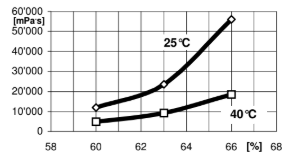
Fig.4.2.1: Initial viscosities at 25°C and 40°C in function of different filler content (DY 044: 0 pbw),
(measurements with Rheomat 260, MS 125, D = 10 s-1)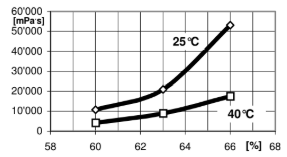
Fig.4.2.2: Initial viscosities at 25°C and 40°C in function of different filler content (DY 044: 20 pbw),
(measurements with Rheomat 260, MS 125, D = 10 s-1)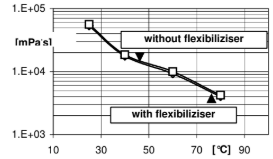
Fig.4.3: Initial viscosity in function of temperature
(DY 044: 0 pbw. and DY 044: 20 pbw), (measurements with Rheomat 260, MS 125, D = 10 s-1)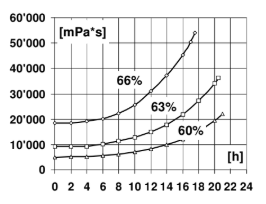
Fig.5.1.1: Viscosity increase at 40°C in function of different filler content
(DY 044: 0 pbw), (measurements with Rheomat 260, MS 125, D = 10 s-1)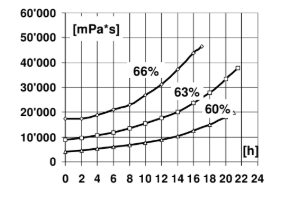
Fig.5.1.2: Viscosity increase at 40°C in function of different filler content (DY 044: 20 pbw),
(measurements with Rheomat 260, MS 125, D = 10 s-1)
Technical Details & Test Data
- Gelation / Cure Time
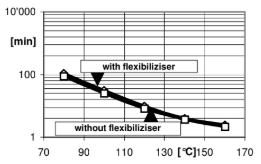
Fig.5.2 Geltime measured in function of temperature, (DY 044: 20 pbw and DY 044: 0)
(measurements with Gelnorm Instrument (ISO 9396)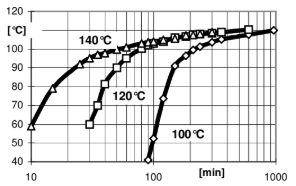
Fig.5.3.1:Glass transition temperature in function of cure time
(DY 044: 0 pbw), (isothermic reaction, ISO 11357-2)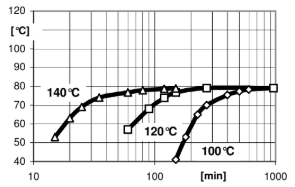
Fig.5.3.2: Glass transition temperature in function of cure time,
(DY 044: 20 pbw), (isothermic reaction, ISO 11357-2)- Mechanical & Physical Properties
Determined on standard specimen at 23°C.
Cured for: 2h at 100°C + 16h at 140°C.Tested System:
Araldite CY 184
Aradur HY 1235100
90100
90DY 044
20
DY 062
0.6
0.6
Silbond W12 EST
370
410
Property
Test Method
Unit
Value 1
Value 2
Tensile Strength
ISO 527
MPa
90 - 100
80 - 90
Elongation at Break
ISO 527
%
0.80 - 1.10
1.10 - 1.40
Modulus from Tensile Test
ISO 527
MPa
14000 - 15000
12000 - 13000
Flexural Strength
ISO 178
MPa
150 - 160
150 - 160
Surface Strain
ISO 178
%
1.25 - 1.75
1.50 - 2.00
E Modulus from Flexural Test
ISO 178
MPa
12500 - 13000
11500 - 12000
Impact Strength
ISO 179-93
kJ/m²
9.5 - 12.5
8.5 - 11.5
Critical Stress Intensity Factor (KIC)
CG 216-0/89
MPa·m½
2.4 - 2.8
2.8 - 3.2
Specific Energy at Break (GIC)
CG 216-0/89
J/m²
410 - 590
540 - 720
Martens Temperature
DIN 53458
°C
90 - 105
65 - 75
Glass Transition Temperature (DSC)
IEC 11357-2
°C
105 - 115
75 - 85
Coefficient of Linear Thermal Expansion
ISO 11359-2
K⁻¹
34 · 10⁻⁶
44 · 10⁻⁶
Thermal Conductivity Similar to
ISO 8894-1
W/m·K
1.0 - 1.1
1.0 - 1.1
Flammability
UL 94
class
V1
Limiting Oxygen Index (LOI)
ASTM D2863/95
%
24.3
-
Water Absorption (10 days at 23°C)
ISO 62
% by wt.
0.05 - 0.15
0.05 - 0.15
Decomposition Temperature
DTA
°C
appr. 350
appr. 350
Density (Filler Load: 66% by wt.)
ISO 1183
g/cm³
1.91 - 1.95
1.92 - 1.96
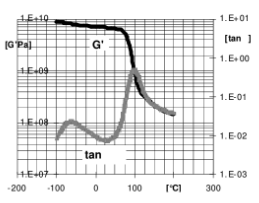
Fig.6.1.1: Shear modulus (G') and mechanical loss factor (tan δ) in function of temperature,
(DY 044: 0 pbw)
(ISO 6721 method C, measured at 1Hz)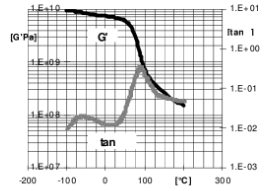
Fig.6.1.2: Shear modulus (G') and mechanical loss factor (tan δ) in function of temperature,
(DY 044: 20 pbw)
(ISO 6721, method C, measured at 1Hz)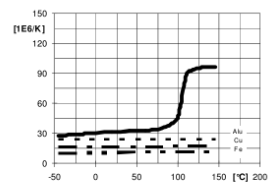
Fig.7.1.1: Coefficient of linear thermal expansion (α) in function of temperature, (DY 044: 0 pbw)
(ISO 11359-2 / reference temperature: 23°C)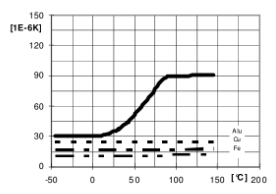
Fig.7.1.2: Coefficient of linear thermal expansion (α) in function of temperature, (DY 044: 20 pbw)
(ISO 11359-2 / reference temperature: 23°C)- Electrical Properties
Determined on standard specimen at 23°C
Cured for 2h at 100°C + 16h at 140°CTested System:
Araldite CY 184
Aradur HY 1235100
90100
90DY 044
-
20
DY 062
0.6
0.6
Silbond W12 EST
370
410
Property
Test Method
Unit
Value 1
Value 2
Breakdown Strength (3mm plates)
IEC 60243-1
kV/mm
18 - 20
29
Diffusion Breakdown Strength
DIN/ VDE 0441/1
class
HD 2
HD 2
Temperature of Specimen After Test
IEC 61621
°C
> 25
> 25
HV Arc Resistance
IEC 61621
s
189 - 193
187 - 190
Tracking Resistance (with test solution A)
IEC 60112
CTI
> 600.0
> 600.0
Tracking Resistance (with test solution B)
IEC 60112
CTI
> 600.0
> 600.0
HV Tracking Resistance
DIN VDE 0441/1
class
HK2
HK2
Electrolytic Corrosion
IEC 60426
grade
A1
A1
Initial Tracking Voltage (i.t.v.)
ASTM D2303
kV/mm
4; 25
4; 25
Time to Track (t.t.t.)
ASTM D2303
h
>15
>15
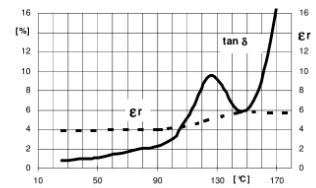
Fig.8.1.1: Loss factor (tan δ) and dielectric constant (εr) in function of temperature, (DY 044: 0 pbw),
(measurement frequency: 50 Hz / IEC 60250)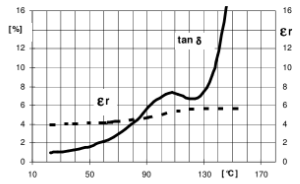
Fig.8.1.2: Loss factor (tan δ) and dielectric constant (εr) in function of temperature, (DY 044: 20 pbw)
(measurement frequency: 50 Hz / IEC 60250)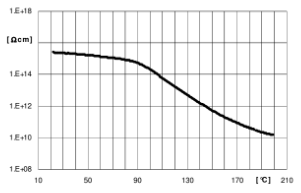
Fig.8.2.1: Volume resistivity (ρ) in function of temperature, (DY 044: 0 pbw)
(measurement voltage: 1000 V/ IEC 60093)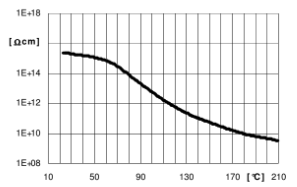
Fig.8.2.2: Volume resistivity (ρ) in function of temperature, (DY 044: 20 pbw)
(measurement voltage: 1000 V/ IEC 60093)- Specific Instructions
The effective pot-life is about 1 day at temperature below 25°C. Conventional batch mixers should be cleaned once a week or at the end of work. For longer interruptions of work, the pipes of the mixing and metering installations have to be cooled and cleaned to prevent sedimentation and/or undesired viscosity increase. Interruptions over a weekend (approx. 48h) without cleaning are possible if the pipes are cooled at temperature below 18°C. In case to use mixtures with high reactivity, we recommend to clean daily with the flexibilizer DY 040.
Viscosity increase and gel time at various temperatures, refer to Figs: 4
Mould temperature
Conventional vacuum casting : 80 - 100°C
APG process : 130 - 150°C
Demoulding times (depending on mould temperature and casting volume)
Conventional vacuum casting : 2 - 4 h
APG process : 10 - 30 min
Cure conditions (minimal post cure)
Conventional vacuum casting : 4h at 80°C + 10h at 140°C
APG process : 16h at 140°CFor any outdoor application, we recommend the use of silanised silica flour. Adgain it is essential to achieve a thorough crosslinking. To determine whether crosslinking has been carried to completion and the final proper-ties are optimal, it is necessary to carry out relevant measurements on the actual object or to measure the glass transition temperature. Different gel and postcuring cycles in the manufacturing process could influence the crosslinking and the glass transition temperature respectively.
Storage & Handling
- Storage Conditions
ARADUR® HY 1235 BD is sensitive to humidity, partly emptied containers should be closed tightly immediately after use. It is necessary to store this product in the sealed original container.
The components have to be stored in tightly sealed and dry original containers according to the storage conditions on the product label. Under these conditions, the shelf life will correspond to the expiration date stated on the label. After this date, the product may be processed only following reanalysis. Partialy emptied containers should be closed tightly immediately after use.
